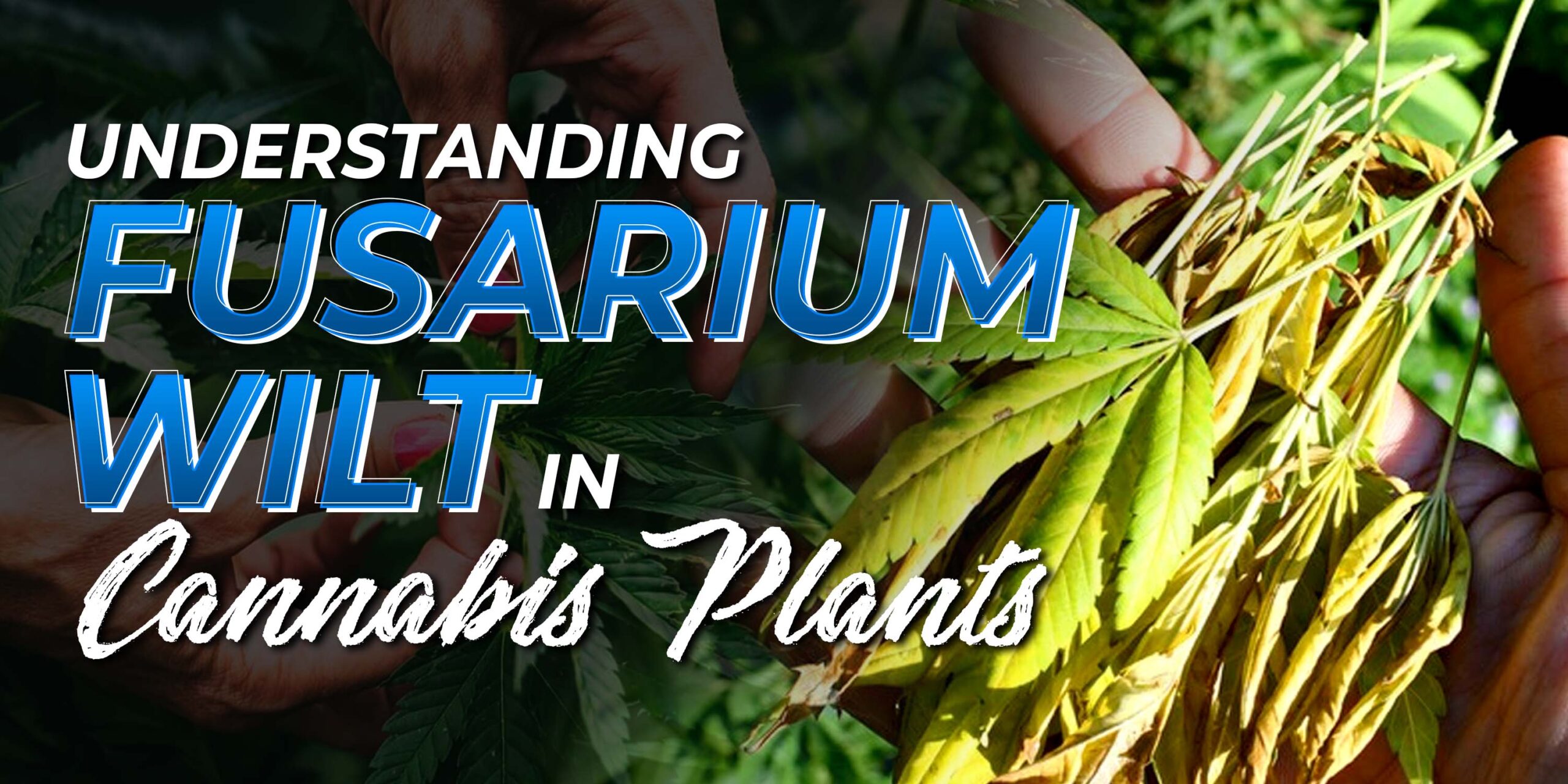Are You 21 Or Over?
YesOr
No By clicking yes, you certify that you are over 21 years old. By using this website, you agree to our legal disclaimer.Table of Contents

Fusarium wilt cannabis represents a significant threat to cannabis cultivation, necessitating a comprehensive understanding of its intricacies. In this extensive guide, we delve deeper into the nuances of fusarium wilt, encompassing its etiology, manifestations, preventive measures, and management strategies.
Fusarium, commonly referred to as fusarium wilt, is a fungal pathogen notorious for its detrimental impact on cannabis and other plant species. Originating from fusarium fungi, this pathogen affects plants and manifests in human beings, leading to dermatomycosis and onychomycosis, underscoring its clinical significance.
The historical inception of fusarium dates back to the 1930s-40s in the USSR, where it was initially observed in wheat infections. Subsequently, its virulence led to its weaponization, highlighting the severity of its impact. Within cannabis cultivation, fusarium predominantly targets roots and stems, inducing symptoms such as growth inhibition, wilting, and eventual plant demise.
Fusarium exhibits distinctive characteristics, thriving in substrates rich in decomposing organic matter: certain strains, notably Fusarium Oxysporum sp., Vasinfectum, and Fusarium Oxysporum Sp. Cannabis poses a substantial threat to cannabis plants due to their aggressiveness. Moreover, the pathogen’s ability to disseminate rapidly via water, wind, and nematodes exacerbates its potency.
Fusarium wilt manifests in various forms within cannabis plants, each with its unique pathological features:
Early detection of fusarium infection is imperative for effective management. Common indicators include leaf discoloration, stem staining, and root necrosis. Advanced stages may manifest as severe stem necrosis and pronounced wilting, necessitating prompt intervention to mitigate further spread.
Fusarium’s life cycle encompasses diverse spore types, including micro macronidia, and chlamydospores, each exhibiting varying degrees of resilience and longevity. Optimal conditions for proliferation are facilitated by temperatures ranging from 10 to 30°C, with indoor cultivation settings providing an ideal breeding ground.
Fusarium-induced damage encompasses a spectrum of physiological disruptions, including root rot, chlorosis, and stem necrosis, ultimately culminating in plant mortality. Once infected, affected plants exhibit irreversible symptoms, necessitating stringent preventive measures to mitigate its spread.
Effective prevention of fusarium wilt entails the implementation of meticulous sanitation practices, encompassing substrate sterilization, personal hygiene, and the judicious use of organic antagonists such as Trichoderma. Additionally, incorporating stress-alleviating products and natural enemies of fusarium further bolsters plant resilience against infections.
Trichoderma emerges as a formidable ally in combating fusarium wilt, exerting multifaceted effects ranging from substrate competition to antibiotic production and root stimulation. Its eco-friendly nature and compatibility with organic cultivation methods underscore its indispensability in cannabis cultivation.
In summary, a comprehensive understanding of fusarium wilt is essential for safeguarding cannabis crops against its deleterious effects. By adopting proactive preventive measures and leveraging biological controls such as Trichoderma, growers can mitigate the risk of fusarium infestation and ensure optimal yields.
Q: Can fusarium wilt spread from one plant to another?
A: Yes, fusarium wilt can spread from infected plants to healthy ones through soil, water, and contaminated gardening tools.
Q: How can I prevent fusarium wilt in my cannabis plants?
A: To prevent fusarium wilt, maintain clean growing environments, avoid overwatering, use disease-resistant plant varieties, and employ beneficial microorganisms like Trichoderma.
Q: Can I use chemical fungicides to treat fusarium wilt?
A: Chemical fungicides may not be effective against fusarium wilt and can harm beneficial soil microbes. Instead, opt for organic alternatives like Trichoderma and cultural practices to manage the disease.
Q: Can fusarium wilt affect indoor and outdoor cannabis growth?
A: Yes, fusarium wilt can affect cannabis plants in indoor, outdoor, and greenhouse environments, as it thrives in various growing conditions and substrates.
Q: Are there any early warning signs of fusarium wilt in cannabis plants?
A: Yes, early signs of fusarium wilt include wilting leaves, discoloration, and dark staining on stems or roots. Promptly address these symptoms to prevent further spread of the disease.

Curious about growing weed in a healthy, effective way? Welcome to the realm of weed hydro! This method uses water instead of soil, delivering n

Peyote Zkittlez is a unique cannabis strain that has quickly gained dedicated followers among enthusiasts and patients alike. Its parentage—Zk

As growers, we want strains that work well, are strong, and are of good quality. Autoflowering cannabis strains are a big step forward for both

Pot growers always ask the same basic question: How much weed does a weed plant produce? The answer is complex and depends on a multitude of var

Ever had the room spin after a few hits? You're not alone. Figuring out how to prevent getting dizzy high can make your cannabis experience a wh

Drying cannabis properly is a critical process in preserving the plant's full aroma and flavor and its psychoactive abilities. Tampering with th

Ever caught yourself a bit too high and all of a sudden in need of being normal? Whether you're heading out for munchies or bumping into someone

Looking for sage advice on how not to get pinched with weed without batting an eye? Attempting to protect your stash from gossipy roommates, sno

Nutrient lockout, also known as nutrient binding or chemical antagonism, is a significant issue in cannabis cultivation that negatively impacts

Germination is the most critical initial stage in growing healthy, high-quality cannabis plants. During germination, the dormant seed becomes a
Are You 21 Or Over?
YesOr
No By clicking yes, you certify that you are over 21 years old. By using this website, you agree to our legal disclaimer.
Excellent blog here Also your website loads up very fast What web host are you using Can I get your affiliate link to your host I wish my web site loaded up as quickly as yours lol
Your writing is not only informative but also incredibly inspiring. You have a knack for sparking curiosity and encouraging critical thinking. Thank you for being such a positive influence!
Simply wish to say your article is as amazing The clearness in your post is just nice and i could assume youre an expert on this subject Well with your permission let me to grab your feed to keep updated with forthcoming post Thanks a million and please carry on the gratifying work
Somebody essentially lend a hand to make significantly articles Id state That is the very first time I frequented your website page and up to now I surprised with the research you made to make this actual submit amazing Wonderful task
Your blog is a beacon of light in the often murky waters of online content. Your thoughtful analysis and insightful commentary never fail to leave a lasting impression. Keep up the amazing work!
Thank you for the auspicious writeup It in fact was a amusement account it Look advanced to more added agreeable from you By the way how could we communicate
Your blog is a constant source of inspiration for me. Your passion for your subject matter shines through in every post, and it’s clear that you genuinely care about making a positive impact on your readers.
Your blog is a constant source of inspiration for me. Your passion for your subject matter is palpable, and it’s clear that you pour your heart and soul into every post. Keep up the incredible work!
Your articles never fail to captivate me. Each one is a testament to your expertise and dedication to your craft. Thank you for sharing your wisdom with the world.
Your blog is a testament to your dedication to your craft. Your commitment to excellence is evident in every aspect of your writing. Thank you for being such a positive influence in the online community.
Your writing has a way of resonating with me on a deep level. I appreciate the honesty and authenticity you bring to every post. Thank you for sharing your journey with us.
Your blog is a true gem in the world of online content. I’m continually impressed by the depth of your research and the clarity of your writing. Thank you for sharing your wisdom with us.
Hi i think that i saw you visited my web site thus i came to Return the favore Im attempting to find things to enhance my siteI suppose its ok to use a few of your ideas
Somebody essentially help to make significantly articles Id state This is the first time I frequented your web page and up to now I surprised with the research you made to make this actual post incredible Fantastic job
Usually I do not read article on blogs however I would like to say that this writeup very compelled me to take a look at and do so Your writing taste has been amazed me Thanks quite nice post
Your blog has quickly become one of my favorites. Your writing is both insightful and thought-provoking, and I always come away from your posts feeling inspired. Keep up the phenomenal work!
Every time I visit your website, I’m greeted with thought-provoking content and impeccable writing. You truly have a gift for articulating complex ideas in a clear and engaging manner.
Hey there You have done a fantastic job I will certainly digg it and personally recommend to my friends Im confident theyll be benefited from this site
I have read some excellent stuff here Definitely value bookmarking for revisiting I wonder how much effort you put to make the sort of excellent informative website
Nice blog here Also your site loads up very fast What host are you using Can I get your affiliate link to your host I wish my site loaded up as quickly as yours lol
What i do not understood is in truth how you are not actually a lot more smartlyliked than you may be now You are very intelligent You realize therefore significantly in the case of this topic produced me individually imagine it from numerous numerous angles Its like men and women dont seem to be fascinated until it is one thing to do with Woman gaga Your own stuffs nice All the time care for it up
Your blog is a beacon of light in the often murky waters of online content. Your thoughtful analysis and insightful commentary never fail to leave a lasting impression. Keep up the amazing work!
Your blog is a breath of fresh air in the often stagnant world of online content. Your thoughtful analysis and insightful commentary never fail to leave a lasting impression. Thank you for sharing your wisdom with us.
Your blog is a beacon of light in the often murky waters of online content. Your thoughtful analysis and insightful commentary never fail to leave a lasting impression. Keep up the amazing work!
Usually I do not read article on blogs however I would like to say that this writeup very compelled me to take a look at and do it Your writing style has been amazed me Thank you very nice article
Your writing has a way of resonating with me on a deep level. I appreciate the honesty and authenticity you bring to every post. Thank you for sharing your journey with us.
This hydroponics guide is quite the buzz, seriously! Who knew growing weed without dirt could be so complicated yet potentially rewarding? The breakdown of systems like DWC and NFT is helpful, though I suspect my cat might confuse the air pump for a toy. The idea of cleaner buds is tempting, especially since explaining hydro weed to my non-growing friends might get messy. And the bit about potential dizziness from hydro weed? Perfect, now I have an excuse for why I always stumble a bit after a grow session. Still, the promise of faster grows and higher yields is hard to ignore, even if it means more trips to the pH meter than to the coffee shop. Overall, a cultivating read for the curious grower!